Gaganyaan
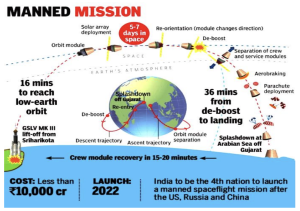
- India‘s first Human Space Flight Programme .
- The programme will make India the fourth nation in the world to launch a Human Spaceflight Mission, only after the USA, Russia and China
- It aims to send a three-member crew to space for a period of five to seven days.
- The spacecraft will be placed in a low earth orbit of 300-400km.
- The crew will be selected by Indian Air Force (IAF) and ISRO jointly after which they will undergo training for two-three years.
- The Gaganyaan mission was initially announced in 2018 targeting a launch in 2022. But due to pandemic-induced delays, India’s maiden manned space mission will only launch by the end of 2024 or Early 2025.
- Geosynchronous Satellite Launch Vehicle (GSLV) MK III has been identified as the launcher for the Gaganyaan mission
- The first trial (uncrewed flight) for Gaganyaan is being planned by the end of 2023 or early 2024. This will be followed by sending Vyom Mitra, a humanoid and then with the crew onboard.
Re-entry & Recovery tech (Tested)
- Came back to Earth after being taken to an altitude of 126 km into space. This is known as Crew module Atmospheric Re-entry Experiment (CARE).
Crew Escape System
- Emergency escape measure to quickly pull the astronaut crew out to a safe distance from launch vehicle .
Environmental Control & Life Support System (ECLSS)
- For humans inside to live comfortably
- Maintains a steady cabin pressure and air composition
- Removes carbon dioxide and other harmful gases
- Controls temperature and humidity
Vyommitra
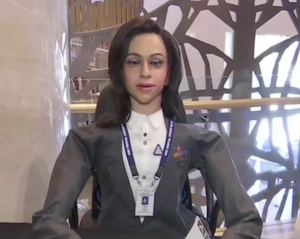
ISRO‘s first woman half-humanoid astronaut.
- Simulate human functions before real astronauts in Gaganyaan crew take off.
- It will be used for an unmanned flight of ISRO‘s GSLV III rocket (Gaganyaan Mission)
- ISRO will send the human-resembling model in a space capsule to study how she and later real astronauts respond to living outside earth in controlled zero gravity conditions.
- She can detect and give out warnings if environmental changes within the cabin get uncomfortable to astronauts and change the air condition.
- She can take up postures suited for launch and tasks and take commands.
Functions
- Replacing carbon dioxide canisters
- Operating switches
- Monitoring of the crew module
- Receiving voice commands
- Responding via speech (bilingual)
Mangalyaan mission over (MOM)
The Indian Space Research Organisation confirmed that the Mars Orbiter craft has lost communication with ground station, it’s non-recoverable and the Mangalyaan mission has attained end-of-life.
About
- MOM was launched on November 5, 2013, and after completing 300 days of interplanetary journey, it was inserted to the Martian orbit on September 24, 2014.
- Despite being designed for a life-span of six months as a technology demonstrator, the MOM has lived for about eight years in the Martian orbit with a gamut of significant scientific results on Mars as well as on the Solar corona, before losing communication with the ground station, as a result of a long eclipse in April 2022, the national space agency said
- According to experts and reports, the Mangalyaan craft ran out of fuel due to back-to-back eclipses, especially the one which continued for over seven hours.
Mangalyaan mission over
Instruments
- For Atmospheric studies (Lyman-Alpha Photometer (LAP)
- Methane Sensor for Mars (MSM),
- Particle environment studies(Mars Exospheric Neutral Composition Analyser (MENCA),
- Surface imaging studies (Thermal Infrared Imaging Spectrometer (TIS),
- Mars Colour Camera (MCC)
Significance
- It is the most cost-effective interplanetary mission (only 450 crore) NASA spent 4000 crore of rupees on MAVEN.
- Space research is not waste of time and money. (For eg.1999 Odisha cyclone killed >10000 people. But 2013 cyclone Phailin killed very few, because Indian satellite gave accurate weather prediction
- No country has ever reached Mars on its first attempt
- As ISRO establishes reputation, gets more contracts from foreign countries and more foreign exchange
- It can be used as a tool to exercise soft power by sending space missions of third world countries and SAARC countries.
- Inspiration and catalyst for innovation in the country
Criticism
- Wastage of resources: Some critics say that Crores of rupee wasted-could be used to remove hunger, malnutrition, improve sanitation.
- Orbit is highly elliptical
- The closest approach to Mars. That too, maybe for 30-40 min.
- This is a costly “me-too” mission and would merely be a duplication of other Mars probes
- Its camera and other sensors are not as capable for probe as MAVEN’s and other MARS missions.
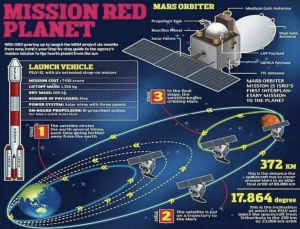
Chandrayaan-3
- ISRO’s Chandrayaan-3 mission will be a follow up to the Chandrayaan-2 mission, which failed to achieve a soft landing on the Moon. Just like Chandrayaan-2, Chandrayaan-3 will carry a lunar lander and a lunar rover to Earth’s lone natural satellite.
- The mission is scheduled to launch aboard a Launch Vehicle 3 (LVM3) rocket, earlier known as the GSLV 3, in June this year.
- The mission’s propulsion module will carry the lander and rover configuration to an orbit that is about 100 kilometres above the Moon’s surface.
- The module will also carry a Spectro-polarimetry of HAbitable Planet Earth (SHAPE) payload to study the spectral and polarimetric measurements of Earth from the lunar orbit.
- Meanwhile, the mission’s lunar lander will carry instruments like Chandra’s Surface Thermophysical Experiment (ChaSTE) to measure the thermal conductivity and temperature; Instrument for Lunar Seismic Activity (ILSA) for measuring the seismicity around the landing site; Langmuir Probe (LP) to estimate the plasma density and its variations. A passive Laser Retroreflector Array from NASA will also hitch a ride aboard the lander.
The mission objectives of Chandrayaan-3 are:
- To demonstrate Safe and Soft Landing on Lunar Surface
- To demonstrate Rover roving on the moon and
- To conduct in-situ scientific experiments.
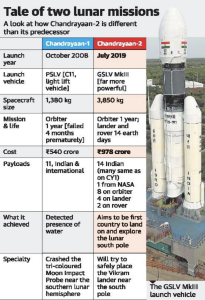
LVM3 M2 / OneWeb India-1 Mission
The heaviest rocket of the Indian Space Research Organisation – LVM3-M2/OneWeb India-1 blasted off from this spaceport to place 36 broadband communication satellites into the Low Earth Orbit (LEO) for a UK-based customer.
NSIL
- NewSpace India Limited (NSIL), a central public sector enterprise under the Department of Space, had earlier signed two launch service contracts with the London-headquartered Network Access Associated Limited (OneWeb) for launching OneWeb LEO satellites on board ISRO’s LVM3.
LVM3
- The vehicle is also dubbed as one of the heaviest for its ability to carry satellites upto 8,000 kg.
- The mission assumes significance as this was LVM3’s maiden commercial mission and also NSIL’s first with the said launch vehicle.
- According to ISRO, the mission has the heaviest payloads with 36 satellites of OneWeb, becoming the first Indian rocket with a payload of 5,796 kg.
- The launch is also first for LVM3-M2 to place the satellites in the Low Earth Orbit (up to 1,200 kms above the earth) unlike Geosynchronous Transfer Orbit (GTO).
- ISRO scientists have rechristened the launch vehicle its present name from GSLV-MKK III as the newest rocket is capable of launching 4,000 kilogram class of satellites into GTO and 8,000 kgs of payloads into LEO.
- GSLV-Mk III had four successful missions in the past.LVM3-M2 is a three-stage launch vehicle consisting of two solid propellant S200 strap-ons on its sides and core stage comprising L110 liquid stage and C25 cryogenic stage.OneWeb Ltd is a global communication network powered from space, enabling internet connectivity for governments and businesses.
OneWeb
- OneWeb is a private satellite communications company, in which India’s Bharti Enterprises is a major investor and shareholder.
The heaviness of rockets
- Very few countries have the capability to launch satellites weighing more than 2 tonnes.
- Until recently, even ISRO used to take the services of Ariane rockets of Europe to launch its heavy satellites.
- The LVM3 rocket, which used to be called GSLV Mk-III earlier, is meant to end that dependence, and also become the vehicle for the more ambitious parts of India’s space programmes — manned missions, Moon landings and deep space explorations — in the near future.
India’s rockets
- India currently has three operational launch vehicles — the Polar Satellite Launch Vehicle or PSLV, of which there are multiple versions; the Geosynchronous Satellite Launch Vehicle or GSLV Mk-II; and the Launch Vehicle Mark-3 or LVM3.
- The PSLV has been the most commonly used, having carried as many as 53 successful missions since 1993. Only two flights of PSLV have failed.
- The GSLV-MkII rocket has been used in 14 missions, of which four have ended in failures, most recently in August last year.
- The LVM3 has flown five times, including the Chandrayaan 2 mission, and has never disappointed.
- In addition, ISRO has been working on a reusable launch vehicle (RLV). Unlike other rockets, the RLV would not end up in space as waste. Instead, it can be brought back and refurbished for use multiple times.
Heavier rockets
- LVM3 is the culmination of more than three decades of efforts to indigenously develop a rocket that can carry heavier payloads, or venture much deeper into space. These requirements not only result in a massive increase in the size of the rocket, but also necessitate a change in the engines and the kind of fuel being used.
- Compared to vehicles that ply on land, or even on water, rockets are an extremely inefficient medium of transport.
- The passenger (or payload) comprises barely 2 to 4 per cent of the weight of the rocket. Between 80 and 90 per cent of the launch-time weight of any space mission is the fuel, or the propellant. This is because of the unique nature of a space journey, which involves overcoming the tremendous force of gravity.
- The LMV3 rocket, for example, has a lift-off mass of 640 tonnes, and all it can carry to lower earth orbits (LEO) — about 200 km from the Earth’s surface — is a mere 8 tonnes.
- To the geostationary transfer orbits (GTO) that lie farther ahead — up to about 35,000 km from Earth — it can carry much less, only about 4 tonnes. However, the LMV3 is not particularly weak when compared to the rockets being used by other countries or space companies for similar jobs.
- The Ariane 5 rockets, frequently used by ISRO earlier for its heavy payloads, has a lift-off mass of 780 tonnes, and can carry 20-tonne payloads to lower earth orbits and 10 tonnes to GTO.
- The Falcon Heavy rockets from SpaceX, supposed to be the most powerful modern launch vehicles, weigh over 1,400 tonnes at launch time, and can carry payloads weighing only about 60 tonnes.
Aditya L1
The Indian Institute of Astrophysics, Bengaluru recently handed over the primary payload Visible Emission Line Coronograph (VELC)of the country’s first mission to sun (Aditya L1) to the Indian Space Research Organisation (ISRO) for integration with the other payloads on board the satellite.
- Aditya-L1, the mission to observe the sun from a vantage point 1.5 million kilometres from the earth, is likely to be launched by June or July this year after being delayed repeatedly through the pandemic.
- The satellite will be carried by India’s trusted rocket Polar Satellite Launch Vehicle
- To get an unobstructed, continuous view of the sun, the satellite will travel to the L1 or Lagrange point between the sun and the earth.
VLEC
- Visible Emission Line Coronograph’ (VELC) will be the main payload among seven designed to study various aspects of the sun like its atmosphere, solar wind acceleration and the origin of coronal mass ejection.
- It may help is solving one of the main puzzles of solar astrophysics — why the sun’s atmosphere called corona is a million degrees hot even though the surface is just over 5,700 degrees Celsius?
- To do this, the scientists have to observe the corona right from its lowermost parts upwards, which is difficult to do owing to the bright light emanating from the sun’s surface.
- However, VELC has an ‘internal occulter’, which separates the light from the surface and discards it. The remaining light from the corona is sent for further processing. The VELC weighs 90kg and is 1.7mx1.1mx700mm in dimension.
- The VELC can image the solar corona down to 1.05 times the solar radius, which is the closest any such payload has imaged. It can also take these observations roughly 3 times every second, and with a high resolution of 2.5 arcseconds per pixel.
- No other solar coronagraph in space has the ability to image the solar corona as close to the solar disk as VELC can. It can image it as close as 1.05 times the solar radius.
- Not only will it generate high resolution pictures of the corona, it will also maintain a temperature of 22 degrees C by radiating away the enormous heat and light from the solar surface. It is also one of the most precise instruments made in India.
Lagrange Points
- Not only will it generate high resolution pictures of the corona, it will also maintain a temperature of 22 degrees C by radiating away the enormous heat and light from the solar surface. It is also one of the most precise instruments made in India.
Lagrange Points
- are positions in space where objects sent there tend to stay put. At Lagrange points, the gravitational pull of two large masses precisely equals the centripetal force required for a small object to move with them.
- This mathematical problem, known as the General Three-Body Problem.
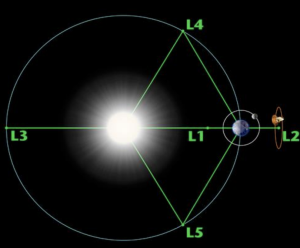
➡️UPSC 2023 General Studies Course: https://sleepyclasses.com/general-studies-for-upsc/
➡️Sociology Optional for UPSC : https://sleepyclasses.com/sociology-for-upsc/
➡️Political Science and IR for UPSC: https://sleepyclasses.com/psir-for-upsc/
➡️Signup here – https://sleepyclasses.com/
Have any query related to UPSC preparation: 📞Contact Us ► Toll-Free: 1800 890 3043 ► Mobile: 6280133177 ► Email: Sleepy.Classes@gmail.com ► WhatsApp: 6280133177



